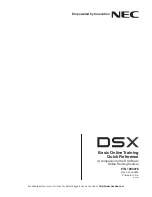
1.1.2 Introduction
These programming instructions are designed to serve as an overall system programming reference for the
PBX. Each feature in the PBX has default settings that can be changed to customise the PBX to your
requirements. These settings control the functions of the PBX, and changing them is referred to as "system
programming".
Programming can be performed by system installers, on-site managers, and individual users. However,
managers and individual users may only change a limited number of settings. For details, see
All features and settings of the PBX can be programmed through system programming with Web Maintenance
Console. Starting Web Maintenance Console is described in
programming items are described from
Section 3 Web Maintenance Console Home Screen
.
Programming Modes
There are two different modes available for programming using Web Maintenance Console:
•
On-line Mode
On-line mode allows you to use Web Maintenance Console on a PC that is connected to the PBX to modify
the system data and settings used by the PBX. Settings can be modified and results are displayed in real
time. Modifications to settings change the information in the PBX’s temporary memory (DRAM). To finalise
the changes, you must either save the changes to the PBX’s Storage Memory Card by clicking or log
out of Web Maintenance Console by clicking
. For details, see
Web Maintenance Console Features
in
.
•
Off-line Mode
Off-line mode allows you to connect to a version of Web Maintenance Console running on your PC. Using
Off-line mode, you can create new system data files and make modifications to system data files stored
on your PC, without being connected to the PBX. After you finish configuring settings, they can be saved
and uploaded to the PBX, which will update the PBX’s settings. For details, see
1.2.2 PC Programming Using Off-line Mode
.
16
PC Programming Manual
1.1.2 Introduction
Summary of Contents for KX-NS1000
Page 18: ...Table 2 For CE model 18 PC Programming Manual 1 1 3 Entering Characters...
Page 19: ...Table 3 For RU model PC Programming Manual 19 1 1 3 Entering Characters...
Page 20: ...Table 4 For GR model 20 PC Programming Manual 1 1 3 Entering Characters...
Page 34: ...34 PC Programming Manual 1 2 3 PBX Configuration Types...
Page 60: ...60 PC Programming Manual 2 3 Frequently Asked Questions FAQ...
Page 452: ...452 PC Programming Manual 9 34 2 PBX Configuration 1 5 2 Configuration DSP Resource Usage...
Page 576: ...576 PC Programming Manual 10 11 2 PBX Configuration 2 11 2 System Audio Gain Card...
Page 600: ...5 1 2 Group 600 PC Programming Manual 11 4 PBX Configuration 3 4 Group Paging Group...
Page 646: ...646 PC Programming Manual 11 12 2 PBX Configuration 3 12 2 Group VM DTMF Group Group Settings...
Page 742: ...742 PC Programming Manual 12 3 PBX Configuration 4 3 Extension DSS Console...
Page 758: ...758 PC Programming Manual 13 5 PBX Configuration 5 5 Optional Device External Sensor...
Page 834: ...834 PC Programming Manual 18 5 PBX Configuration 10 5 CO Incoming Call Miscellaneous...
Page 898: ...898 PC Programming Manual 20 1 3 UM Configuration 1 3 Mailbox Settings Auto Configuration...
Page 922: ...922 PC Programming Manual 22 2 UM Configuration 3 2 UM Extension Trunk Service Port Assignment...
Page 956: ...956 PC Programming Manual 23 4 UM Configuration 4 4 Service Settings Holiday Table...
Page 990: ...990 PC Programming Manual 24 4 UM Configuration 5 4 System Parameters Parameters...
Page 998: ...998 PC Programming Manual 26 1 UM Configuration 7 System Security...
Page 1115: ...Section 29 Appendix PC Programming Manual 1115...
Page 1122: ...1122 PC Programming Manual 29 1 5 PCMPR Software File Version 004 0xxxx...
Page 1123: ...Feature Programming References PC Programming Manual 1123...
Page 1181: ...5 2 4 5 Wireless XDP Parallel Mode PC Programming Manual 1181 Feature Programming References...
















































